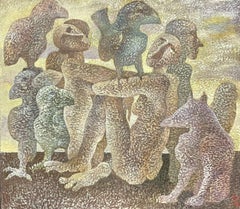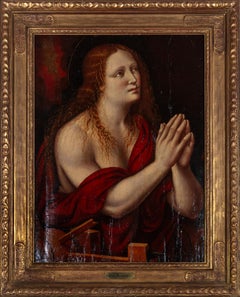Russian School Figurative Paintings
to
1
1
1
1
1
Overall Height
to
Overall Width
to
1
1
1
1
1
1
1
1
3
437
221
203
102
2
1
1
1
1
Artist: Russian School
Russian Icon 16th century The Battle of the Novogorodians with the Suzdalians
By Russian School
Located in London, GB
The Battle of the Novogorodians with the Suzdalians
16th century
Size 50.5 x 47.5 x 3 cm.
The icon is located in the Russian Federation.
There is an expert opinion from leading R...
Category
16th Century Old Masters Russian School Figurative Paintings
Materials
Wood, Egg Tempera, Wood Panel
HUGE RUSSIAN SURREALIST ABSTRACT FIGURATIVE OIL PAINTING - SIGNED & DATED 2001
By Russian School
Located in Cirencester, Gloucestershire
Artist/ School: Russian School, indistinctly signed verso and dated 2001.
Title: Surrealist figurative group
Medium: oil painting on canvas signed
S...
Category
21st Century and Contemporary Russian School Figurative Paintings
Materials
Canvas, Oil
Related Items
Belisama
By Oswaldo Vigas
Located in Palm Beach, FL
Predominantly recognized as a self-taught painter, he also worked in architectural murals, sculptures, ceramics, prints and drawings.
Vigas is one...
Category
1960s Cubist Russian School Figurative Paintings
Materials
Canvas, Oil, Gouache, Board
"Caterina d'Alexandria (Saint Catherine of Alexandria)" classical religious
By (After) Giampietrino
Located in Milwaukee, WI
"Caterina d'Alexandria (Saint Catherine of Alexandria)" is an original oil painting on wood panel, likely painted by Italian artist Giampietrino (Giovanni Pietro Rizzoli). The painti...
Category
19th Century Old Masters Russian School Figurative Paintings
Materials
Oil, Wood Panel
Italian Landscape With Figures at a Waterfall by a Follower of Jan van Huysum
By Jan Van Huysum
Located in Stockholm, SE
There are so many details to fall in love with in this 18th-century painting depicting an Italianate landscape, for example, the delicately painted figures having a conversation and ...
Category
Early 18th Century Old Masters Russian School Figurative Paintings
Materials
Wood Panel, Oil
Free Shipping
H 9.65 in W 13.98 in
Large Japanese Wood Board Ema Namban Depicting a Portuguese Ship Edo period
Located in Stockholm, SE
An Ema is a votive plaque people hang in a "dedication area", at a Shinto shrine, with their wish to the gods. Wishes usually would revolve around health, love, career, prosperity, a...
Category
Mid-19th Century Realist Russian School Figurative Paintings
Materials
Wood, Tempera, Egg Tempera, Wood Panel
Old Woman and Boy with Candles, Oil on Panel, 1800s
Located in Stockholm, SE
In this painting titled "Old Woman and Boy with Candles" an intriguing scene unfolds before our eyes. An older woman gazes ahead, her eyes shielded from the flickering candlelight, w...
Category
19th Century Old Masters Russian School Figurative Paintings
Materials
Oil, Wood Panel
"Green Hat"
By Gershon Benjamin
Located in Lambertville, NJ
Ashley John is proud to offer this artwork by:
Gershon Benjamin (1899 - 1985)
Gershon Benjamin is a painter of portraits, landscapes, still lives, and the urban scene. He had a pro...
Category
20th Century Abstract Russian School Figurative Paintings
Materials
Canvas, Oil
Baptism of Christ
Located in New York, NY
Provenance:
Achillito Chiesa, Milan
Luigi Albrighi, Florence, by 1 July 1955
with Marcello and Carlo Sestieri, Rome, 1969
Private Collection, Connecticut
Exhibited:
Mount Holyoke College Art Museum, South Hadley, Massachusetts (on loan, 2012)
Literature:
Carlo Volpe, “Alcune restituzioni al Maestro dei Santi Quirico e Giulitta,” in Quaderni di Emblema 2: Miscellanea di Bonsanti, Fahy, Francisci, Gardner, Mortari, Sestieri, Volpe, Zeri, Bergamo, 1973, pp. 19-20, fig. 18, as by the Master of Saints Quiricus and Julitta (now identified as Borghese di Piero).
This fine predella panel depicting the Baptism...
Category
15th Century and Earlier Old Masters Russian School Figurative Paintings
Materials
Wood Panel, Tempera
The Resurrection of Christ
Located in New York, NY
Provenance:
with “Mr. Scheer,” Vienna, by July 1918; where acquired by:
Jindřich Waldes, Prague, 1918–1941; thence by descent to:
Private Collection, New York
Literature:
Rudolf Kuchynka, “České obrazy tabulové ve Waldesově obrazárně,” Památky archeologické, vol. 31 (1919), pp. 62-64, fig. 5.
Jaroslav Pešina, “K datování deskových obrazů ve Waldesově obrazárně,” Ročenka Kruhu pro Pěstování Dějin Umění: za rok (1934), pp. 131-137.
Jaroslav Pešina, Pozdně gotické deskové malířství v Čechách, Prague, 1940, pp. 150-151, 220.
Patrik Šimon, Jindřich Waldes: sběratel umění, Prague, 2001, pp. 166, 168, footnote 190.
Ivo Hlobil, “Tři gotické obrazy ze sbírky Jindřicha Waldese,” Umění, vol. 52, no. 4 (2004), p. 369.
Executed sometime in the 1380s or 1390s by a close associate of the Master of the
Třeboň Altarpiece, this impressive panel is a rare work created at the royal court in Prague and a significant re-discovery for the corpus of early Bohemian painting. It has emerged from an American collection, descendants of the celebrated Czech industrialist and collector Jindřich Waldes, who died in Havana fleeing Nazi-occupied Europe.
The distinctive visual tradition of the Bohemian school first began to take shape in the middle of the fourteenth century after Charles IV—King of Bohemia and later Holy Roman Emperor—established Prague as a major artistic center. The influx of foreign artists and the importation of significant works of art from across Europe had a profound influence on the development of a local pictorial style. Early Italian paintings, especially those by Sienese painters and Tommaso da Modena (who worked at Charles IV’s court), had a considerable impact on the first generation of Bohemian painters. Although this influence is still felt in the brilliant gold ground and the delicate tooling of the present work, the author of this painting appears to be responding more to the paintings of his predecessors in Prague than to foreign influences.
This Resurrection of Christ employs a compositional format that was popular throughout the late medieval period but was particularly pervasive in Bohemian painting. Christ is shown sitting atop a pink marble sarcophagus, stepping down onto the ground with one bare foot. He blesses the viewer with his right hand, while in his left he holds a triumphal cross with a fluttering banner, symbolizing his victory over death. Several Roman soldiers doze at the base of the tomb, except for one grotesque figure, who, beginning to wake, shields his eyes from the light and looks on with a face of bewilderment as Christ emerges from his tomb. Christ is wrapped in a striking red robe with a blue interior lining, the colors of which vary subtly in the changing light. He stands out prominently against the gold backdrop, which is interrupted only by the abstractly rendered landscape and trees on either side of him.
The soldiers’ armor is rendered in exacting detail, the cool gray of the metal contrasting with the earth tones of the outer garments. The sleeping soldier set within a jumble of armor with neither face nor hands exposed, is covered with what appears to be a shield emblazoned with two flies on a white field, somewhat resembling a cartouche (Fig. 1). This may be a heraldic device of the altarpiece’s patron or it may signify evil, referencing either the Roman soldiers or death, over both of which Christ triumphs.
This painting formed part of the collection assembled by the Czech industrialist and founder of the Waldes Koh-i-noor Company, Jindřich Waldes, in the early twentieth century. As a collector he is best remembered for establishing the Waldes Museum in Prague to house his collection of buttons (totaling nearly 70,000 items), as well as for being the primary patron of the modernist painter František Kupka. Waldes was also an avid collector of older art, and he approached his collecting activity with the goal of creating an encyclopedic collection of Czech art from the medieval period through to the then-present day. At the conclusion of two decades of collecting, his inventory counted 2331 paintings and drawings, 4764 prints, and 162 sculptures. This collection, which constituted the Waldesova Obrazárna (Waldes Picture Gallery), was first displayed in Waldes’ home in Prague at 44 Americká Street and later at his newly built Villa Marie at 12 Koperníkova Street. This Resurrection of Christ retains its frame from the Waldes Picture Gallery, including its original plaque “173 / Česky malíř z konce 14 stol.” (“Czech painter from the end of the 14th century”) and Waldes’ collection label on the reverse.
The Resurrection of Christ was one of the most significant late medieval panel...
Category
15th Century and Earlier Old Masters Russian School Figurative Paintings
Materials
Tempera, Panel
Moses Strikes the Water from the Rock. XVII cent. Dutch school.
Located in Firenze, IT
Moses Strikes Water from the Rock Dutch school, XVII century. Workshop of Jacob de Wet (Haarlem, 1610-1675).
Technique: Oil on oak wood panel, composed of 3 horizontal panels.
In this evocative work, Moses stands in a cave, gathering the Israelites. There was no water to drink or for their cattle. The people were discontented in the desert.
But Moses and Aaron listened to the voice of God. With Aaron’s staff, Moses struck the rock, and water gushed forth abundantly, quenching their thirst.
Jacob de Wet’s workshop specializes in subjects from the Old and New Testaments.
The recognizable rectangular format, simple compositions, and clear narratives define his style. The interplay of light and shadow, reminiscent of Rembrandt, adds timeless allure. The characters’ costumes, with their large hats and turbans...
Category
17th Century Old Masters Russian School Figurative Paintings
Materials
Oil, Wood Panel
Dutch School, 17th Century, Shipping in a Stiff Breeze, a City Beyond
Located in Stockholm, SE
We are delighted to present a significant piece from the Dutch School, most likely dating back to the late 17th century. This captivating painting showcases the dynamic force of nature with three ships vigorously navigating through stormy waters. The foreground is a scene of nautical struggle, as figures are depicted working intensely with the sails, steering, and bracing against the tumultuous sea.
In the serene background, the silhouette of a quaint town emerges, with spires from churches and the outlines of various buildings is visible. This juxtaposition of the calm town against the chaotic foreground serves as a powerful reminder of the unpredictability of life and nature.
Dominating the canvas, the sky occupies two-thirds of the painting, filled with brooding clouds that occasionally break to reveal patches of blue. The presence of birds adds a dynamic element to the otherwise ominous atmosphere.
While the artist remains unknown, the work is quintessentially Dutch in its execution, with meticulous attention to detail and a profound understanding of maritime life. The painting's oval shape is quite distinctive and is complemented by a suitably antique octagonal black frame, which adds to its historical charm.
This piece is a testament to the mastery of Dutch maritime painting...
Category
17th Century Old Masters Russian School Figurative Paintings
Materials
Oak, Oil, Wood Panel
Study for a Fish at Sea with Three Flags-Ink, egg-tempera and gold leaf on panel
By Konstantinos Papamichalopoulos
Located in Dallas, TX
Konstantinos Papamichalopoulos was born in Athens, Greece in 1975. He studied painting and printmaking at the Athens School of Fine Arts, where he also received a postgraduate degree...
Category
2010s Contemporary Russian School Figurative Paintings
Materials
Gold Leaf
H 7.88 in W 15.75 in D 1.19 in
Untitled, 1965
By Oswaldo Vigas
Located in Palm Beach, FL
Predominantly recognized as a self-taught painter, he also worked in architectural murals, sculptures, ceramics, prints and drawings.
Vigas is one...
Category
1960s Cubist Russian School Figurative Paintings
Materials
Canvas, Oil, Gouache, Board
Russian School figurative paintings for sale on 1stDibs.
Find a wide variety of authentic Russian School figurative paintings available for sale on 1stDibs. You can also browse by medium to find art by Russian School in canvas, fabric, oil paint and more. Not every interior allows for large Russian School figurative paintings, so small editions measuring 30 inches across are available. Russian School figurative paintings prices can differ depending upon medium, time period and other attributes. On 1stDibs, the price for these items starts at $3,066 and tops out at $3,066, while the average work can sell for $3,066.


